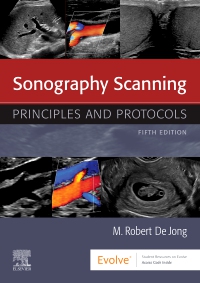Sonography Scanning, 5th Edition
by M. Robert deJong, RDMS, RDCS, RVT, FSDMS
Paperback
ISBN:
9780323597388
Copyright:
2021
Publication Date:
11-19-2020
Page Count:
768
Imprint:
Saunders
List Price:
$134.99
-
-
- Scanning principles and step-by-step instructions on how to scan and document images helps students improve the quality of sonographic studies and establish standardization and image documentation for physician diagnostic interpretation.
- Sonographic ergonomics and proper use of equipment helps students avoid occupational injuries.
- Scanning protocol for pathology provides the criteria for evaluating and documenting abnormal sonographic findings, describing those findings within legal parameters, and relating those findings to the interpreting physician.
- Key words and objectives at the beginning of every chapter notify students of the pertinent information in the following chapter.
-
- NEW! Updated content reflects the latest ARDMS standards and AIUM guidelines.
- NEW! Thoroughly updated scanning protocols follow AIUM guidelines and offer essential information on patient preparation, transducers, breathing techniques, comprehensive surveys, and required images.
- NEW! Flexible soft cover makes it easy to take notes and transport content.
-
Part I
1. Clinical Principles
2. Scanning Planes and Scanning Methods
Part II
3. Scanning Protocol for Abnormal Findings
Part III
4. Abdominal Aorta Scanning Protocol
5. Inferior Vena Cava Scanning Protocol
6. Liver Scanning Protocol
7. Gallbladder and Biliary Tract Scanning Protocol
8. Pancreas Scanning Protocol
9. Renal Scanning Protocol
10. Spleen Scanning Protocol
11. Image Protocol for Full and Limited Studies of the Abdomen
Part IV
12. Female Pelvis Scanning Protocol
13. Transvaginal Sonography
14. Obstetrics Scanning Protocol for First, Second, and Third Trimesters
15. Male Pelvis Scanning Protocol for the Prostate Gland, Scrotum, and Penis
Part V
16. Thyroid and Parathyroid Glands Scanning Protocol
17. Breast Scanning Protocol
18. Neonatal Brain Scanning Protocol
19. Musculoskeletal Scanning Protocol NEW!
Part VI
20. Abdominal Doppler and Color Flow
21. Cerebrovascular Duplex Scanning Protocol
22. Peripheral Arterial and Venous Duplex Scanning Protocols
Appendices
A Guidelines for Performance of the Abdominal and Retroperitoneal Ultrasound Examination
B Guidelines for Performance of the Scrotal Ultrasound Examination
C Guidelines for Performance of the Antepartum Obstetrical Ultrasound Examination
D Guidelines for Performance of the Ultrasound Examination of the Female Pelvis
E Guidelines for Performance of the Ultrasound Examination of the Prostate (and Surrounding Structures)
-
M. Robert deJong, RDMS, RDCS, RVT, FSDMS, Radiology Technical Manager - Ultrasound, The Russell H. Morgan Department of Radiology and Radiological Science, The Johns Hopkins Hospital, Baltimore, Maryland, USA




 as described in our
as described in our 